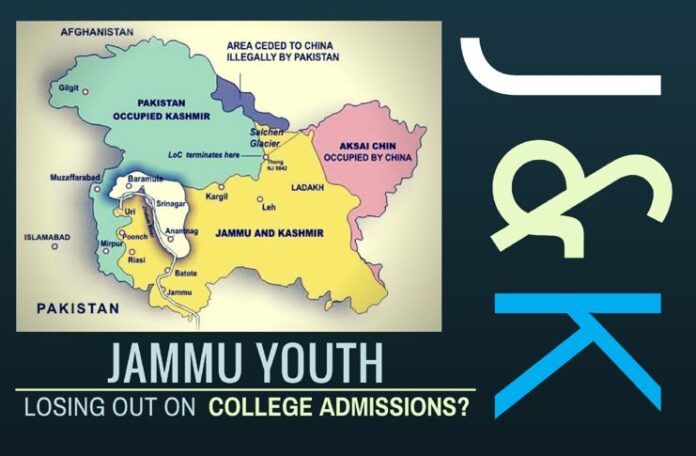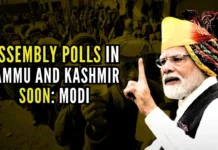
[dropcap color=”#008040″ boxed=”yes” boxed_radius=”8px” class=”” id=””]T[/dropcap]he youth of Jammu division are a frustrated and dissatisfied lot. They are extremely angry with the system. They have several grouses against the authorities in the State. Two of them are fundamental. One is that the employment policy, which has been in vogue in the State since 1948, is Kashmir-centric. The grievance is genuine. For example, the rate of unemployment in Jammu division, according to official statistics, is more than 69%, as against less than 30% in Kashmir province.
There are almost 4.5 lakh employees working in the government and semi-government establishments in the State, but the number of employees from Jammu division is not more than one lakh.
Similarly, the proportion of Kashmir and Jammu in the official service sector is approximately 75:25. There are almost 4.5 lakh employees working in the government and semi-government establishments in the State, but the number of employees from Jammu division is not more than one lakh. They want the State Government to adopt and introduce a new employment policy that ensures regional balance and gives them a sense of belonging. The population of Jammu division is equal to that of Kashmir, if not more, and Jammu contributes almost 75% revenue annually to the State exchequer.
The other complaint is that the share of the Jammu youth in the government-run and aided technical and professional institutions such as medical colleges is negligible. They say that while the Kashmir-based technical and professional institutions and Agriculture University have become the sole preserve of the Valley youth, they also get disproportionate share in the Jammu-based similar institutions. They want the State Government to implement the January 13, 1999 RP Singhal Committee Report on admission to technical and professional institutions in the State.
The Committee had candidly acknowledged that the Jammu youth hardly got their due share in such institutions. The Committee, which was set up vide Government Order No. 442-GAD of 1998, dated April 7, 1998, after a careful scrutiny of the MBBS/BDS selection lists of the past eight years, had said that the Jammu’s share in the Medical Colleges dwindled from 60% in 1990 and 52% in 1991 and 1993 to 38% in 1994, 41% in 1995, 36% in 1996, 20% in 1997 and a paltry 17% in 1998 (Review and Reform of Entrance Test for Medical and Technical Courses in Jammu & Kashmir, p.4). Things by and large remain the same even today with the Jammu youth crying for justice and fair play.
The 3-member Committee found out a way to meet the demand of the Jammu youth without harming the interests of the Valley youth. It recommended that the only way to maintain regional balance as far as admissions to the technical and professional institutions was concerned was to adopt admission rules as were in vogue in the University of Jammu and University of Kashmir under the Jammu & Kashmir Universities Act of 1969. Its recommendation read: “As is the existing practice for admissions to Polytechnic courses where one Common Entrance Test is held, but the selection list is declared separately for the two divisions, the Competent Authority may hold one Common entrance Test for the two divisions for Medical and Engineering Courses, but the selection lists may be separately issued for the two divisions. The admissions in these colleges (Government as well as Private) should be made by the respective Universities in accordance with the prevalent admission rules under their Acts. The seats in Jammu Colleges (Medical as well as Engineering) should be earmarked for candidates belonging to Jammu region and those in Kashmir Colleges be earmarked for candidates belonging to Kashmir region. A certain number of seats may be reserved in each of the University for Ladakh region in proportion to its population” (P.20).
[dropcap color=”#008040″ boxed=”yes” boxed_radius=”8px” class=”” id=””]T[/dropcap]he report, which was commended by the people of Jammu division in general and Jammu youth in particular, continues to gather dust in the Kashmiri-dominated Civil Secretariat. In between, the National Conference (NC) ruled the State for six years, the Peoples Democratic Party (PDP)-Congress coalition Government for six years, the NC-Congress coalition Government also for six years and the PDP-BJP coalition Government has been ruling the State since March 1, 2015, but none of these Kashmir-centric governments thought it prudent to implement the Singhal Committee Report to dispense justice to the aggrieved and rigorously excluded Jammu youth.
The entire Jammu province was up in arms after the publication of what the people of this ignored region condemned as a “highly biased” 1998 MBBS/ BDS selection lists.
It would be only proper to refer to the circumstances under which the then Farooq Abdullah Government had to set up the 3-member Committee to look into the oft-repeated complaint of the people of Jammu province that it all along got crumbs. The entire Jammu province was up in arms after the publication of what the people of this ignored region condemned as a “highly biased” 1998 MBBS/ BDS selection lists. All the business establishments remained closed in Jammu for 17 days. Schools, colleges and University of Jammu remained closed for almost two months between February and May 1998. Jammu witnessed a number of clashes with the police. Many students were injured and arrested. The fact of the matter is that the State Government used all means, including excessive force, to bring the situation under control, but with no result, as nothing deterred the determined and agitating people. Such was the nature of the movement in Jammu against the State Government that Chief Minister Farooq Abdullah had no other option but to kneel and set up a Committee. Had he not done so, his Government would have collapsed like the Government of Ghulam Nabi Azad collapsed on July 7, 2008 under pressure from below. Jammu was up in arms in 2008 as well and the issue that had triggered a massive anti-establishment movement was the withdrawal of the valid High Court order under which a small piece of land at Baltal in Kashmir had been transferred to the Shri Amarnath Shrine Board (SASB) on a temporary basis for the creation of some additional facilities for the Amarnath pilgrims.
Now that the BJP is part of the Jammu & Kashmir Government, it is time for it to do what the biased and vindictive Kashmiri ruling elite didn’t do to conciliate the angry Jammu youth. The BJP has everything to gain and nothing to lose by following a courageous policy.
- ‘Kashmir My core constituency’: Revisiting July 12, 2003 to understand politics, Omar Abdullah-style - March 15, 2024
- Total deviation from traditional approach: Seven takeaways from PM Modi’s March 7 Srinagar visit - March 9, 2024
- Status of political parties: Why is further J&K reorganization imperative? - March 1, 2024










